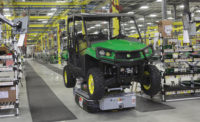Things certainly have changed. Now, the Augusta, GA, plant relies on computerized systems and advanced technologies to manufacture high-quality tractors.
According to Chip LaPole, project manager, there are 3,500 assembly steps for the 5000 Series tractors. However, the entire job can be completed in less than 4 hoursthanks to an innovative approach to assembly. The tractors start out riding on automated guided vehicles (AGVs) supplied by AGV Products Inc. (Charlotte, NC).
Deere builds its 5000 Series of utility tractors on top of wire-guided AGVsa key part of the fully integrated and networked assembly line. The assembly line is more than one-quarter of a mile long and has 106 workstations. The plant’s AGV fleet consists of 62 vehicles that serve as platforms on which tractors ride along the 1,452-foot assembly line.
"The assembly line is laid out like a racetrack," explains LaPole. "The line has two spur or feeder lines for engine and transmission assembly. Six AGVs work the engine line, and six more work on the transmission line. The remaining 50 AGVs loop around the main line. The AGVs then mesh with operators at the workstations."
Meanwhile, operations managers follow the tractors on computer monitors. Assembly operators get their instructions and quality control information from the computerized system that is accessible from touchscreen monitors throughout the plant. System software uses radio frequency communication to directly interact with the AGVs’ onboard computers and transceivers to control and track AGV movements.
Networking helps assure that the AGV will not move from a specific assembly station until the work is complete and verified. The control system then verifies quality control data to guarantee acceptance. Also, the AGV only stops at assembly stations where work is required on the specific tractor that is being transported. The vehicle will bypass stations where no assembly is needed.
The 62 wire-guided AGVs are centered around a single vehicle design. Each vehicle is capable of carrying 7,200 pounds and is outfitted with one of three custom fixtures. Custom fixturing depends on whether it will carry a tractor chassis, engine or transmission.
The three-wheeled AGVs have a forward steer and drive wheel, and two fixed rear wheels. A 48-volt battery powers separate steer and drive motors. An onboard, microprocessor-based system called TRACE 2000 controls each vehicle and communicates by radio signals with a base control unit. For most routing operations at Deere, the vehicles travel at a speed of approximately 40 fpm.
As an added safety measure, the AGVs are equipped with a mechanical bumper, infrared object detection sensors, audible and visual warning devices, a loss-of-guidance braking function, emergency stop pushbuttons, and an automatic and manual key switch. If needed, the AGVs can be operated manually.
"AGV routing is easy to modify. Simply cut a small groove into the floor, lay more wire, fill in the cut with epoxy, and route the vehicles in a new direction. Thus, the handling and manufacturing system’s layout can be changed quickly and economically. That’s important because the utility tractor business is very dynamic. John Deere is always thinking of a better way to give the customer the highest value products," says LaPole.
For more information on automated guided vehicles, call 704-845-1110 or visit www.agvp.com.



